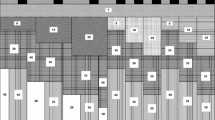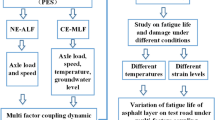Abstract
The objective of this study is to evaluate pavement fatigue of both the 12.5 mm+PG58-22 and 12.5 mm+PG64-22 asphalt mixtures by evaluation of the pavement damage index, which is calculated based on the simulated dynamic load and the fracture parameter. The pavement damage index is the change in the pavement fatigue life between a target profile and an as-built profile. To achieve the objective, the dynamic load was simulated based on the pavement surface profile, vehicle speed, and vehicle suspension. The dynamic load increases when the surface profile is rougher, while the incensement of the dynamic load on rougher pavements is accentuated when the speed is higher. For the two asphalt mixtures, the coefficient of variance of the simulated dynamic load and the fracture parameter, which is calculated from the slope of the linear portion of the creep compliance, are used to calculate the pavement damage index. The pavement damage index increases as both the variance of the dynamic load and the confidence level increase. At lower temperatures, the value of n increases. This result indicates that, as the temperature decreases, a larger reduction in the fatigue life of the pavement is expected for the same pavement surface profiles. The 12.5 mm+PG64-22 asphalt mixture has a larger reduction in the pavement fatigue life than the 12.5 mm+PG58-22 asphalt mixture.
Similar content being viewed by others
References
Fernandes, J. and Barbosa, R. (2006). “Effects of axle load, suspension system, vehicle speed and pavement condition on dynamic loads.” Proc. 10th International Conference on Asphalt Pavements, Quebec, Canada CD-Rom
Gillespie, T. D., Karamihas, S. M., Cebon, D., Sayers, M. W., Nasim, M. A., Hansen, W., and Ehsan, N. (1992). Effects of heavy vehicle characteristics on pavement response and performance, UMTRI 92-2, The University of Michigan Transportation Research Institute, Ann Arbor, Michigan, USA.
Lenngren, C. and Granlund, J. (2002). “Relating road roughness to human discomfort and health impact.” Proc. 9th International Conference on Asphalt Pavements, St. Paul, Minnesota, USA, CDRom.
Lytton, R. L. Uzan, J., Fernando, E., Roque, R., Hiltunen, D., and Stoffels, S. M. (1993). Development and validation of performance prediction models and specifications for asphalt binders and asphalt mixes, SHRP-A-357, Strategic Highway Research Program, National Research Council, Washington, D.C., USA.
Mar, S. and Caprez, M. (1995). “The pavement roughness requirement for WIM.” First European Conference on Weigh-in-Motion of Road Vehicles, Switzerland.
Paris, P. C. and Erdogan, F. (1963). “A critical analysis of crack propagation laws.” Transactions of the ASME, Journal of Basic Engineering, Series, D, Vol. 85, No. 3, pp. 528–534.
Rawool, S. and Fernando, E. (2005). “Methodology for detection of defect locations in pavement profiles.” The Journal of Transportation Research Board, No. 1905, pp. 141–417.
Siddique, Z. and Hossain, M. (2006). “Dynamic wheel loads on superpave pavements.” Proc. 10th International Conference on Asphalt Pavements, Quebec, Canada, CD-Rom.
Smith, K. L, Smith, K. D., Evans, L. D., Hoerner, T. E., Darter, M. I., and Woodstrom, J. H. (1997). Smoothness specifications for pavements, NCHRP Report 1-31, National Cooperative Highway Research Program, Transportation Research Board, Washington, DC, USA.
Sweatman, P. F. (1983). A Study of dynamic wheel forces in axle group suspensions of heavy vehicle, Special Report No. 27, Australian Road Research Board, Vermont South, Victoria, Australia.
UMTRI (1993). The mechanics of heavy-duty trucks and truck combinations, University of Michigan Transportation Research Institute, U. M. Engineering Conferences, Vol. 1, Ann Arbor, Michigan, USA.
Author information
Authors and Affiliations
Corresponding author
Rights and permissions
About this article
Cite this article
Park, DW. Evaluation of predicted pavement fatigue life based on surface profiles and asphalt mixture types. KSCE J Civ Eng 14, 191–196 (2010). https://doi.org/10.1007/s12205-010-0191-8
Received:
Revised:
Accepted:
Published:
Issue Date:
DOI: https://doi.org/10.1007/s12205-010-0191-8




